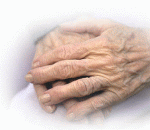Geriatrics
|
4 march 2015 05:38:35 |
| Different ankle muscle coordination patterns and co-activation during quiet stance between young adults and seniors do not change after a bout of high intensity training (BMC Geriatrics) |
|
Tweet Background:
Available evidence suggests that young adults and seniors use different strategies to adjust for increasing body sway during quiet standing. Altered antagonist muscle co-activation and different ankle muscle coordination patterns may account for this finding. Consequently, we aimed at addressing whether aging leads to changes in neuromuscular coordination patterns as well as co-activation during quiet stance. We additionally investigated whether a bout of high intensity interval training additionally alters these patterns.
Methods:
Twenty healthy seniors (age: 70 ± 4 y) and twenty young adults (age: 27 ± 3 y) were enrolled in the present study. In between the testing procedures, four consecutive high-intensity intervals of 4 min duration at a target exercise intensity of 90 to 95% HRmax were completed on a treadmill. The total center of pressure (COP) path length displacement served as standing balance performance outcome. In order to assess ankle-muscle coordination patterns, amplitude ratios (AR) were calculated for each muscle (e.g. tibialis anterior (TA) [%] = (TA × 100) / (gastrocnemius medialis (GM) + soleus (SOL) + peroneus longus (PL) + TA) in order to assess the inter-muscular coordination of the ankle-muscles. The co-activation was calculated for the SOL and TA muscles computing the co-activation index (CAI = 2 × TA / TA + SOL).
Results:
Seniors showed an inverted ankle muscle coordination pattern during single limb stance with eyes open (SLEO), compared to young adults (rest: GM, S: 15 ± 8% vs Y: 24 ± 9%; p = 0.03; SOL, S: 27 ± 14% vs Y: 37 ± 18%; p = 0.009; TA, S: 31 ± 13% vs Y: 13 ± 7%; p = 0.003). These patterns did not change after a high-intensity training sessions. A moderate correlation between amplitude ratios of TA-contribution and postural sway was observed for seniors during SLEO (r = 0.61). Ankle co-activation was twofold elevated in seniors compared to young adults during SLEO (p |
| 110 viewsCategory: Geriatrics |
 Age-dependent visual exploration during simulated day- and night driving on a motorway: a cross-sectional study (BMC Geriatrics) Age-dependent visual exploration during simulated day- and night driving on a motorway: a cross-sectional study (BMC Geriatrics)BMC Geriatrics reviewer acknowledgement 2014 (BMC Geriatrics) 
|
| blog comments powered by Disqus |
MyJournals.org
The latest issues of all your favorite science journals on one page
The latest issues of all your favorite science journals on one page



